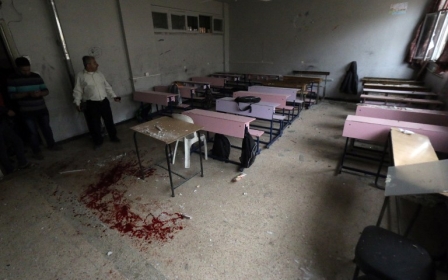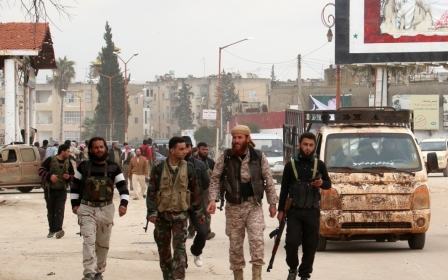UN diplomats: All tears, no action on Syria?

NEW YORK - UN Security Council members watched graphic footage of limp Syrian toddlers frothing from their noses on hospital beds on Thursday - a US effort to shake diplomats into action over recent chemical weapons strikes on civilians.
Envoys heard from victims of gas attacks and Dr Mohamed Tennari, who treated patients after Syrian national forces allegedly dropped chemical bombs on Idlib last month as the al-Qaeda-linked al-Nusra Front advanced on the government-held northwest city.
“The patients had a severe shortness of breath, coughing, wheezing, irritation of the throat and eyes, vomiting and foaming … everyone smelled bleach odour in the air and heard the sounds of helicopters hovering in the skies,” Tennari told reporters after the meeting.
“The people in my city and in Syria expect the Security Council to act. We have been dying every day from missiles and barrel bombs - and now toxic agents. Our message to the international community is: please stop this in Syria.”
While council members were choked up by the graphic footage, fault-lines between the West and Russia - an ally of Syrian President Bashar al-Assad - could leave the 15-nation body split on bringing perpetrators to account, analysts told Middle East Eye.
“If there was a dry eye in the room, I didn’t see it,” the US ambassador to the UN, Samantha Power, told reporters after the closed-door meeting. The use of helicopters and barrel bombs indicated Assad’s forces were behind the strikes, she said.
“We need an attribution mechanism so we know precisely who carried out these attacks,” Power said.
“But we need to move forward in a manner that also makes it very clear to all council members and that those people responsible … are held accountable.”
The US, along with France and Britain, accuse Assad’s forces of using chlorine gas on civilians - a charge Damascus denies. Russia, which can veto UN Security Council moves, says there is no hard evidence of Syrian government culpability.
The global watchdog Organisation for the Prohibition of Chemical Weapons (OPCW) is carrying out a fact-finding mission in Syria on toxic chemical use during last month’s attacks and their report will guide council members on next steps.
The New York-based pressure group Human Rights Watch (HRW) has gathered witness accounts, video and photo evidence indicating that Assad’s forces used toxic chemicals in barrel bomb strikes around Idlib between 16-31 March, affecting at least 206 people, including 20 civil defence workers.
Bomb site evidence suggests that Assad’s forces used canisters typically found in domestic fridges and air conditioners which had been refilled with chlorine gas and dropped from government helicopters in barrel bombs, HRW said.
Chlorine is not a banned substance and is commonly found at swimming pools and water treatment plants, but its deployment as a chemical weapon is prohibited under the 1997 Chemical Weapons Convention, which Syria joined in 2013.
When inhaled, chlorine gas turns to hydrochloric acid in the lungs, causing internal burning and drowning as the lungs fill with fluid. It was first used militarily to devastating effect on the battlefields of northern France during World War I.
Evan Barrett, an analyst for The Coalition for a Democratic Syria, said Moscow’s veto makes the UN redundant on Syria. Even last month’s UN resolution on toxic weapons containing tough language about enforcement lacked any mechanism for implementation, he said.
“There are times when the Security Council doesn’t agree. But even when members do agree, still nothing gets done,” Barrett told MEE.
He said it would be difficult to replicate a deal brokered by the US and Russia in which Syria agreed to destroy its chemical weapons after hundreds of people were killed in a sarin gas attack on the outskirts of the capital, Damascus, in August 2013.
According to the UN, that was the “most significant confirmed use of chemical weapons against civilians since Saddam Hussein used them” against Kurds in Halabja in 1988. Assad’s government has since handed over 1,300 tonnes of toxic chemicals and is destroying production and storage plants.
“But there’s so much chlorine for commercial, private and public use in Syria that removing it is logistically impossible. How do you go about stopping the use of this weapon? I haven’t heard any discussion of what productive steps could be taken on chlorine,” Barrett added.
Nadim Houry, a Middle East expert for HRW, was more hopeful of action in a conflict that began with anti-government protests in March 2011 and spiralled into all-out civil war between the government, rebels and extremists that has claimed 220,000 lives.
“Everyone had thought that after Saddam Hussein we had turned a page on chemical weapons - but here we are again documenting attacks with Sarin and chlorine,” Houry told MEE. “This is not about which side wins Syria’s civil war, it’s about enforcing a global norm against using chemical weapons so that they cannot be used with impunity.”
Qusai Zakarya, a survivor of the August 2013 chemical weapons attack in Ghouta, outside Damascus - which killed hundreds of people and prompted the council to adopt a resolution on destroying Syria’s chemical weapons stockpile - is unsure.
The 29-year-old addressed UN members on Thursday, later telling journalists how his “chest was set on fire. I had to punch my chest so I could get a single breath.” Those who ordered the barrel bombing of his neighbourhood are still evading justice, he said.
“If we can bypass politics and act as humans, maybe we can get something out. I always try to keep my hopes high, but with the history of the Security Council on Syria, I’m not sure I can keep my hopes high,” he said.
According to Barret, diplomatic efforts outside the UN are more promising.
He pointed to growing momentum among US lawmakers and humanitarians towards opening “protected zones” around Aleppo and Idlib. These areas would not have the high-level protection of a no-fly-zone, but could be patrolled by US-trained rebels and allow aid deliveries.
A petition by the online campaign group Avaaz calling for the US and Iran to “negotiate a ceasefire and peace” in Syria has garnered 1.1 million signatures. “There is no evidence though that this kind of momentum will have any effect on the White House’s calculus,” Barret told MEE.
Middle East Eye propose une couverture et une analyse indépendantes et incomparables du Moyen-Orient, de l’Afrique du Nord et d’autres régions du monde. Pour en savoir plus sur la reprise de ce contenu et les frais qui s’appliquent, veuillez remplir ce formulaire [en anglais]. Pour en savoir plus sur MEE, cliquez ici [en anglais].




